Abstract
Shunting inhibitory cellular neural networks with continuous time-varying rates and inputs are the focus of this research. A new model is considered with compartmental passive decay rates which consist of periodic and Poisson stable components. The first component guarantees the Poisson stability of the dynamics, and the second one causes irregular oscillations. The inputs are Poisson stable to take into account the more sophisticated environment of the networks. The rates and inputs are synchronized to obtain Poisson stable outputs. A new efficient technique for checking the recurrence, the method of included intervals, is applied. Sufficient conditions for the existence of a Poisson stable solution and its asymptotic stability were obtained. Numerical simulations of Poisson stable outputs as well as inputs are provided. Examples of the model with Poisson stable rates, inputs and outputs confirm the feasibility of theoretical results. Discussions were undertaken to provide additional light on the relation of the obtained results with practical and theoretical potentials of neuroscience. Quantitative characteristics are suggested, which can be useful for the future applications of the results. In particular, the center of antisymmetry for the degree of periodicity is determined.
1. Introduction
Cellular neural networks (CNNs), introduced in [1], immediately gained wide recognition to focus on parallel asynchronous computing processes. In recent years, many algorithms for image processing, pattern recognition, evaluation of the dynamics of mechanical systems, etc., were successfully implemented with CNNs.
Shunting inhibitory cellular neural networks (SICNNs) were proposed in [2] and have been extensively applied in psychophysics, optimization, speech, robotics, adaptive pattern recognition, vision and image processing, among other tasks.
In SICNNs, neighboring cells exert mutual inhibitory interactions of the shunting type. In its original formulation, they describe the dynamics of the cell by the following nonlinear ordinary differential equation,
Here, indicates the th neuron state, coefficient represents the passive decay rate, denotes the strength of the coupling of the cell conveyed to the cell is the activation function, and is the external input to cell
SICNNs are a grid of cells, such that each cell is connected with cells of its r-neighborhood. Here, we follow the definition in [1], where the r-neighborhood is defined as
with fixed natural numbers m and
It is of strong interest to replace the constant rates in SICNNs by time-varying ones, and many researchers have investigated the dynamic behavior of SICNNs, wherein passive decay rates are periodic [3], anti-periodic [4,5], almost periodic [6,7,8] and pseudo-periodic [9,10] functions.
We investigate the following SICNNs with continuous time-varying coefficients:
where the rates are compartmental and consist of two components such that are periodic whilst and inputs are Poisson stable functions.
The following concept is fundamental for the present study.
Definition 1
([11]). A function : bounded and continuous, is said to be Poisson stable if there is a sequence of moments as such that the uniform convergence is valid on each bounded interval of the real axis.
Consider the sequence such that and is a fixed number. It is clear that Hence, there exists a subsequence which converges to a real number Consequently, one can find a subsequence of the convergence sequence such that as The number is said to be Poisson shift for the convergence sequence. The set of all Poisson shifts, is not empty, and is of several or even infinite number elements. In what follows, is called the Poisson number for and
2. Methods
It is historical fact that Poisson stability emerged in works [12,13] and then spread to many areas of applied mathematics, similarly to how periodic, quasi-periodic and almost periodic motions [14,15,16,17,18,19] spread. In recent decades, the dynamics were intensively considered in neuroscience [3,6,7,8,20,21,22,23,24]. Currently, Poisson stable motions are the most sophisticated type of recurrence [25,26,27,28].
It is natural to assume that Poisson stable motions should be considered in neuroscience due to the arguments common with those for other types of recurrence, such as periodicity and almost periodicity. The dynamics admit an additional significant reason to be involved in research since it is strongly adjoint with chaos [29].
A new technique, the method of included intervals, was introduced and developed in papers [30,31,32,33,34,35] and book [36] to approve Poisson stability for solutions in differential equations and neural networks. The approach strongly differs from the comparability method in [37,38,39,40].
In papers [33,34,35], it is shown that the Poisson stable motions became chaotic if one equipped them with the unpredictability property. It is a very remarkable result since it was proven that a chaotic trajectory can be Poisson stable and vice versa. Moreover, the dynamics are enriched with infinitely many unstable recurrent motions [36,41,42] which strongly relate to the cognitive activity [43,44,45,46]. This is why one can apply to the dynamics of neural networks effective methods of chaos control such as OGY method and Piragas method, which are very useful in neural models study and their applications [47].
In this paper, SICNNs with Poisson stable passive decay rates and inputs are studied. Moreover, the rates of cell activity have a special structure consisting of two components. One of them is periodic, responsible for the overall dynamics and stability whilst the second is Poisson stable, causing irregular behavior in SICNNs. The passive decay rates and inputs are synchronized by the common moments of convergence on bounded intervals. The relationship between periodic and Poisson stable functions has been studied in [32].
3. Main Results
Using the result for differential equations [48], one can convince that the following lemma is valid.
Lemma 1.
A function bounded on the real axis, is a solution of (2) if and only if the following equations are true,
Throughout the paper, the norm for bounded functions will be used.
Denote by the set of rectangle matrix-functions with Poisson stable entries such that where H is a positive number. All the functions are with the common convergence sequence Moreover, determine the norm in the set.
Let us define the operator where
We shall need the following assumptions:
- (C1)
- The functions are -periodic, such that
- (C2)
- Functions and are Poisson stable with the common convergence sequence
- (C3)
- The Poisson number is equal to zero;
- (C4)
- ∃ such that
- (C5)
- ∃ such that if
Condition implies that there exist constants which satisfy
for all
We will use notations:
The additional assumptions are required.
- (C6)
- (C7)
Lemmas A1 and A2 for the following proof are from Appendix A.
Theorem 1.
Suppose that assumptions (C1)–(C7) hold; then, the system (1) admits a unique asymptotically stable Poisson stable solution.
Proof.
Firstly, we prove the completeness of Let , be a sequence converging on to a limit function Consider a section and We have that
For sufficiently large p and k, it can be attained that each term on the right hand-side of (5) is less than for an arbitrary small and . The inequalities imply that uniformly on The completeness of is shown.
Under conditions (C1)–(C7), the operator is invariant in (see Lemma A1) and contractive (see Lemma A2). According to the contraction mapping theorem, there exists a unique Poisson stable solution, of the neural network (2).
Now, consider the stability of solution It is correct that for all ,
Let be another solution of model (2). One can write that
Using the formula
we have that
for all
Apply the Gronwall–Bellman Lemma to get
for each
The condition (C6) confirms that the solution is asymptotically stable. □
We shall then illustrate the theoretical results by numerical simulations.
It is known [49] that there exists a Poisson stable sequence which is the solution for the logistic discrete equation
where and is a fixed parameter. The sequence is a discrete version of the Poisson stable function. The section is invariant with respect to (6) for the considered values of
In the examples below, we will use the Poisson stable function [49] which is the unique bounded on the real axis solution of differential equation
where for and h is a positive real number. The number h is called the length of step for the piecewise constant function and for the function
Example 1.
Let us consider the system,
where For each fixed and the coefficients are the same for all such that the cell belongs to The functions are periodic with period , such that The functions and are Poisson stable, where is the solution of Equation (7) with the step of length Below, we shall need the degree of periodicity, which in the present case is equal to .
Since the elements of the convergence sequence are multiples of h and the period is equal to the Poisson number , is equal to zero. Furthermore, where The conditions – of Theorem 1 hold for the network (8) with for all As is the case for Theorem 1, Equation (8) admits a unique asymptotically Poisson stable solution In Figure 1, the solution of SICNNs (8) is shown, which asymptotically converges to
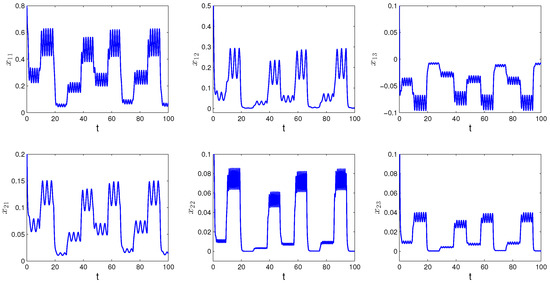
Figure 1.
The solution of the neural network (8) with the degree of periodicity and the initial values .
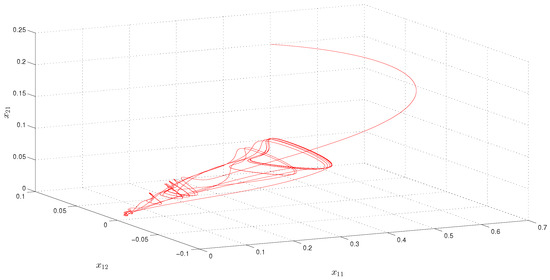
Figure 2.
The coordinates of the solution of the neural network (8) with the degree of periodicity and the initial values .
To emphasize the role of the variable passive rates for the behavior of the outputs, in the next simulations, we consider the constant and Poisson stable components of the passive rates. In Figure 3, the outputs of the neural network (8) with are demonstrated. One can observe that the constancy is combined with the irregular contribution of the inputs.
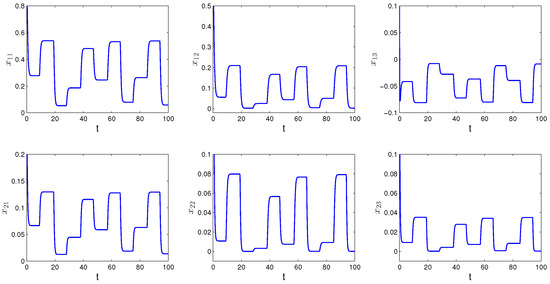
Figure 3.
The solution of the neural network (8) with constant passive decay rates and initial values The degree of periodicity .
Example 2.
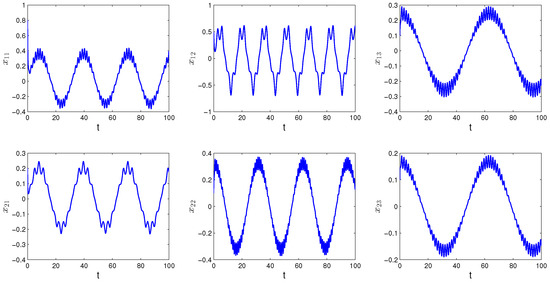
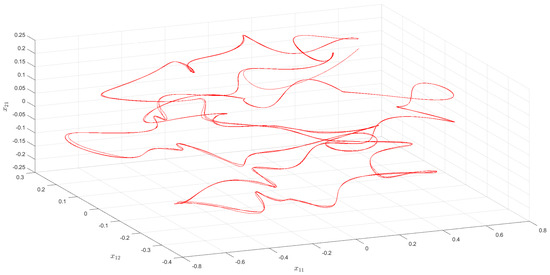
Now, we consider SICNNs (8) where activation function the coupling strength For each fixed and the coefficients are the same for all such that the cell belongs to Functions are π-periodic such that The functions and are Poisson stable such that where is the solution of Equation (7) with the step of length The common period of the functions and equals to and the degree of periodicity is equal to Figure 4 depicts simulation results of SICNNs (8) with initial values The coordinates of the trajectory with the same initial data are shown in Figure 5.

Figure 4.
The solution of the neural network (8) with the degree of periodicity and the initial values .

Figure 5.
The coordinates of the trajectory of the neural network (8). The degree of periodicity is equal to 200.
Comparing Figure 1 and Figure 4, one can understand the importance of the periodicity degree for the models. That is, the periodicity characteristic is seen to be better if the degree is larger than one, and the Poisson stability is better visualized for smaller than one. This is why = 1 is the center of antisymmetry for degree of periodicity.
Example 3.
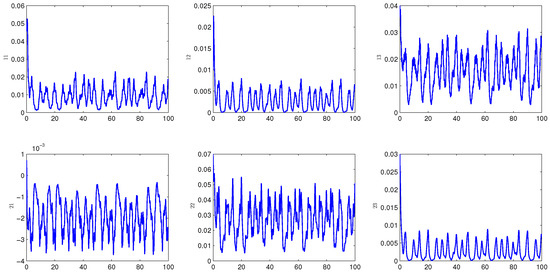
Let us consider the following neural network
where activation function the coupling strength For each fixed and the coefficients are the same for all such that the cell belongs to The functions are 2-periodic such that Functions and are Poisson stable, The function is the solution of SICNNs (8) obtained for with In Figure 6, the solution of (9) with is depicted. In the model, the periodicity degree is equal to 1 and the periodicity is clearly not observable.

Figure 6.
The solution of the SICNNs (9), with a degree of periodicity and initial data .
4. Discussion
In this part of the paper, we provide the ideas behind the theoretical research of the dynamics of neural networks which are useful for applications in engineering. We found that the simulations of our study are similar to those modeled by neural networks in industrial problems. For example, consider tracking of periodical or square waves dynamics. We are confident that one should better learn what can happen in the dynamics of neural networks with a sophisticated environment and structure. Furthermore, the information of the paper is useful in that sense. One can assume that in addition to the tracking periods, amplitudes of the periodical and square wave dynamics, the neural networks’ motions can also be considered for the Poisson sequences. Thus, the instruments for synchronization and control can be significantly improved, if one consider our proposals.
To shed more light for the suggestions and provide several issues for the next observations, let us look not only at the simulations results for the networks in the examples above but simulations for Poisson stable functions, especially driven to compare with the industrial simulations in papers [50,51,52,53,54]. For this reason, let us consider the two-component function where a and b are real coefficients, is the Poisson stable function with step h described in the last section, and the first component is an -periodic function. The parameter is the periodicity degree, which was introduced above in Example 1. It can be very useful for the analysis of time series obtained in different areas—both theoretical and engineering. In Figure 7, Figure 8 and Figure 9, we have the graphs of functions and respectively. The graph of function with the periodicity degree is shown in Figure 7. We obtain the function that admits a clear periodic shape which is enveloped by irregular Poisson stability—which can be said about the dominance of periodicity in this case.
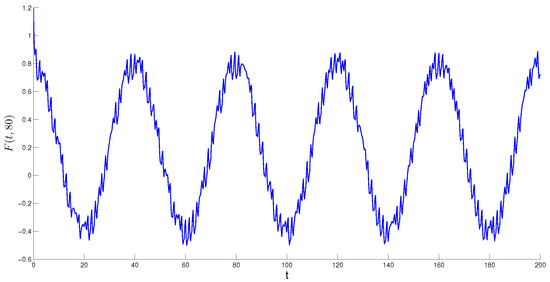
Figure 7.
The graph of function with .
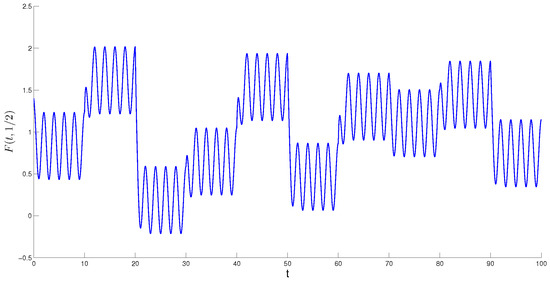
Figure 8.
The graph of function with .
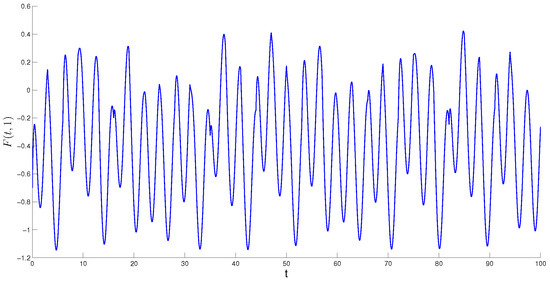
Figure 9.
The graph of function with .
For the function where , and observing its graph in Figure 8, we have the opposite effect, when the irregular stability dominates and the periodicity, which appears locally on separated intervals, envelopes the Poisson stability.
If then the graph of function in Figure 9 demonstrates that both phenomena—periodicity and Poisson stability—are equally present in the dynamics.
To estimate the future prospects of our suggestions, the simulations of the paper were compared with some industrial applications of neural networks. First of all, it was found that examples from an historical hourly weather dataset, Figure 9 in [50], had the same shape as the solution of neural network (8) with the periodicity degree and the initial values in Figure 4. Moreover, it is very similar to the graph of function in Figure 7. It is remarkable that both mathematical objects are with It is important that the dominance is numerically indicated for the value of the periodicity degree larger than one.
Our observations then relate to the values of the degree less than one. In Figure 8 of the paper [51] (track control of 1 Hz square wave (no load)), one can see oscillations similar to Poisson stable motions with in Figure 1 and Figure 8, which are obtained on the basis of our theoretical issues. Analyzing simulations with a periodicity degree smaller than one, one can say that there is a loss of periodicity and dominance of irregularity, which is specified as Poisson stability, while the result in [51] might be accepted as coexistence of the square wave periodicity and the Poisson stability in our comprehension. Nevertheless, we believe that one can use the present theoretical results for qualitative characteristics of the square wave tracking with SICNNs [52,53].
Figure 36(a) in [54] is very similar to our simulations in Figure 6 and Figure 9 with the unit degree of periodicity. This confirms that specific Poisson stable motions can be useful to represent the dynamics of linear and nonlinear single-degree-of-freedom systems, as well as full-scale three-story multi-degree of freedom steel frame [54].
5. Conclusions
In this paper, we considered SICNNs with variable two-component rates and Poisson stable inputs. Sufficient conditions were established to provide the existence of Poisson stable solutions for the SICNNs. The line of periodic, almost periodic and recurrent oscillations in neural networks is continued. Introducing the concept of the degree of periodicity, we showed by examples how it affects the dynamics of neural networks. The suggestions are constructive and suitable for simulations.
Author Contributions
M.A.: conceptualization; methodology; investigation. M.T.: investigation; supervision; writing—review and editing. A.Z.: software; investigation; writing—original draft. All authors have read and agreed to the published version of the manuscript.
Funding
M. Tleubergenova and A. Zhamanshin have been supported by the Science Committee of the Ministry of Education and Science of the Republic of Kazakhstan (grant No. AP08856170 and No. AP09258737). M. Akhmet and A. Zhamanshin have been supported by 2247-A National Leading Researchers Program of TUBITAK, Turkey, N 120C138.
Institutional Review Board Statement
Not applicable.
Informed Consent Statement
Not applicable.
Data Availability Statement
Not applicable.
Acknowledgments
The authors are very thankful to the editor and referees for their valuable comments and suggestions.
Conflicts of Interest
The authors declare no conflict of interest.
Appendix A
In what follows, the basic constructive properties of the operator are provided, which are needed to prove Theorem 1.
Lemma A1.
Suppose that assumptions (C1)–(C7) are true. Then, operator Π is invariant in the set
Proof.
Let a function belong to , then we obtain
for all By conditions (C6) and (C7), we obtain that
We then show that are Poisson stable functions. Consider a fixed number and bounded interval . One can choose numbers such that and which obey the following relations,
for all Since the interval the present technique of discussion is called the method of included intervals.
Because the functions and are Poisson stable, the function belongs to whilst the convergence sequence, is common for all of them, and the Poisson number is equal to zero, by Lemma A2 in [32], it is true that for and for sufficiently large p and We have that
Let us present the sum of integrals in the last inequality as such that
and
One can find that
and
Lemma A2.
Assumptions (C1) and (C4)–(C6) imply that Π is a contraction operator in .
Proof.
Let us take two functions and that belong to It is true that for fixed i and j that the inequality
is valid. This is why By condition , the operator is a contraction in . □
References
- Chua, L.; Yang, L. Cellular neural networks: Applications. IEEE Trans. Circuits Syst. 1988, 35, 1273–1290. [Google Scholar] [CrossRef]
- Bouzerdoum, A.; Pinter, R. Shunting inhibitory cellular neural networks: Derivation and stability analysis. IEEE Trans. Circuits Syst. I Fundam. Theory Appl. 1993, 40, 215–221. [Google Scholar] [CrossRef]
- Li, Y.; Wang, L.; Fei, Y. Periodic Solutions for Shunting Inhibitory Cellular Neural Networks of Neutral Type with Time-Varying Delays in the Leakage Term on Time Scales. J. Appl. Math. 2014, 2014, 496396. [Google Scholar] [CrossRef]
- Huang, C.; Wen, S.; Huang, L. Dynamics of anti–periodic solutions on shunting inhibitory cellular neural networks with multi-proportional delays. Neurocomputing 2019, 357, 47–52. [Google Scholar] [CrossRef]
- Peng, G.; Li, L. Anti–periodic solutions for shunting inhibitory cellular neural networks with continuously distributed delays. Nonlinear Anal. Real World Appl. 2009, 10, 2434–2440. [Google Scholar] [CrossRef]
- Ou, C. Almost periodic solutions for shunting inhibitory cellular neural networks. Nonlinear Anal. Real World Appl. 2019, 10, 2652–2658. [Google Scholar] [CrossRef]
- Li, Y.; Meng, X. Almost periodic solutions for quaternion-valued shunting inhibitory cellular neural networks of neutral type with time delays in the leakage term. Int. J. Syst. Sci. 2018, 49, 2490–2505. [Google Scholar] [CrossRef]
- Li, Y.; Wang, C. Almost periodic solutions of shunting inhibitory cellular neural networks on time scales. Commun. Nonlinear Sci. Numer. Simul. 2018, 17, 3258–3266. [Google Scholar] [CrossRef]
- Lu, Y.; Ji, D. Pseudo almost periodic solutions for shunting inhibitory cellular neural networks with continuously distributed delays. J. Inequalities Appl. 2017, 2017, 242. [Google Scholar] [CrossRef][Green Version]
- Zhang, A. Pseudo Almost Periodic Solutions for SICNNs with Oscillating Leakage Coefficients and Complex Deviating Arguments. Neural Process. Lett. 2017, 45, 183–196. [Google Scholar] [CrossRef]
- Sell, G. Topological Dynamics and Ordinary Differential Equations; Van Nostrand Reinhold Company: London, UK, 1971. [Google Scholar]
- Poincare, H. New Methods of Celestial Mechanics; Dover Publications: New York, NY, USA, 1957. [Google Scholar]
- Birkhoff, G. Dynamical Systems; American Mathematical Society: Providence, RI, USA, 1927. [Google Scholar]
- Nayfeh, A.; Mook, D. Nonlinear Oscillations; Wiley: New York, NY, USA, 1979. [Google Scholar]
- Hoppensteadt, F.; Izhikevich, E. Weakly Connected Neural Networks; Springer: New York, NY, USA, 1997. [Google Scholar]
- Fink, A. Almost Periodic Differential Equations; Springer: New York, NY, USA, 1974. [Google Scholar]
- Levitan, B.; Zhikov, V. Almost Periodic Functions and Differential Equations; Cambridge University Press: Cambridge, UK, 1983. [Google Scholar]
- Corduneanu, C. Almost Periodic Oscillations and Waves; Springer: New York, NY, USA, 2009. [Google Scholar]
- Besicovitch, A. Almost Periodic Functions; Dover: Cambridge, UK, 1954. [Google Scholar]
- Liu, B. Almost periodic solutions for Hopfield neural networks with continuously distributed delays. Math. Comput. Simul. 2007, 73, 327–335. [Google Scholar] [CrossRef]
- Cao, J. New results concerning exponential stability and periodic solutions of delayed cellular neural networks. Phys. Lett. A 2003, 307, 136–147. [Google Scholar] [CrossRef]
- Zhang, L.; Du, B. Periodic solution for inertial neural networks with variable parameters. AIMS Math. 2021, 6, 13580–13591. [Google Scholar] [CrossRef]
- Xu, C.; Pang, Y.; Li, P. Anti–periodic solutions of Cohen-Grossberg shunting inhibitory cellular neural networks on time scales. J. Nonlinear Sci. Appl. 2016, 9, 2376–2388. [Google Scholar] [CrossRef][Green Version]
- Huang, Z. Almost periodic solutions for fuzzy cellular neural networks with multi-proportional delays. Int. J. Mach. Learn. Cybern. 2017, 8, 1323–1331. [Google Scholar] [CrossRef]
- Bender, P. Recurrent solutions to systems of ordinary differential equations. J. Differ. Equ. 1969, 5, 271–282. [Google Scholar] [CrossRef]
- Kumar, A.; Bhagat, R. Poisson stability in product of dynamical systems. Int. J. Math. Math. Sci. 1987, 10, 613–614. [Google Scholar] [CrossRef]
- Hino, Y. Recurrent solutions for linear almost periodic systems. Funkc. Ekvacioj 1985, 28, 117–119. [Google Scholar]
- Knight, R. Recurrent and Poisson stable flows. Proc. Am. Math. Soc. 1981, 83, 49–53. [Google Scholar] [CrossRef]
- Holmes, P. Poincare, celestial mechanics, dynamical-systems theory and chaos. Phys. Rep. 1990, 193, 137–163. [Google Scholar] [CrossRef]
- Akhmet, M.; Tleubergenova, M.; Zhamanshin, A. Poincare chaos for a hyperbolic quasilinear system. Miskolc Math. Notes 2019, 20, 33–44. [Google Scholar] [CrossRef]
- Akhmet, M.; Tleubergenova, M.; Zhamanshin, A. Quasilinear differential equations with strongly unpredictable solutions. Carpathian J. Math. 2020, 36, 341–349. [Google Scholar] [CrossRef]
- Akhmet, M.; Tleubergenova, M.; Zhamanshin, A. Modulo periodic Poisson stable solutions of quasilinear differential equations. Entropy 2021, 23, 1535. [Google Scholar] [CrossRef] [PubMed]
- Akhmet, M.; Seilova, R.; Tleubergenova, M.; Zhamanshin, A. Shunting inhibitory cellular neural networks with strongly unpredictable oscillations. Commun. Nonlinear Sci. Numer. Simul. 2020, 89, 105287. [Google Scholar] [CrossRef]
- Akhmet, M.; Tleubergenova, M.; Zhamanshin, A. Inertial neural networks with unpredictable oscillations. Mathematics 2020, 8, 1797. [Google Scholar] [CrossRef]
- Akhmet, M.; ÇinÇin, D.A.; Tleubergenova, M.; Nugayeva, Z. Unpredictable oscillations for Hopfield–type neural networks with delayed and advanced arguments. Mathematics 2020, 9, 571. [Google Scholar] [CrossRef]
- Akhmet, M. Domain Structured Dynamics: Unpredictability, Chaos, Randomness, Fractals, Differential Equations and Neural Networks; IOP Publishing: Bristol, UK, 2021. [Google Scholar]
- Shcherbakov, B.A. Classification of Poisson—stable motions. Pseudo—recurrent motions. Dokl Akad Nauk. SSSR 1962, 146, 322–324. [Google Scholar]
- Shcherbakov, B.A. Poisson stable solutions of differential equations, and topological dynamics. Differ. Uravn 1969, 5, 2144–2155. [Google Scholar]
- Cheban, D.; Liu, Z. Poisson stable motions of monotone nonautonomous dynamical systems. Sci. China Math. 2019, 62, 1391–1418. [Google Scholar] [CrossRef]
- Cheban, D.; Liu, Z. Periodic, quasi–periodic, almost periodic, almost automorphic, Birkhoff recurrent and Poisson stable solutions for stochastic differential equations. J. Differ. Equ. 2020, 269, 3652–3685. [Google Scholar] [CrossRef]
- Alligood, K.; Sauer, T.; Yorke, J. CHAOS: An Introduction to Dynamical Systems; Springer: New York, NY, USA, 1996. [Google Scholar]
- Devaney, R. An Introduction to Chaotic Dynamical Systems; Addison–Wesley: Menlo Park, CA, USA, 1990. [Google Scholar]
- Skarda, C.; Freeman, W.J. How brains make chaos in order to make sense of the world? Behav. Brain Sci. 1987, 10, 161–173. [Google Scholar] [CrossRef]
- Boccaletti, S.; Grebogi, C.; Lai, Y.; Mancini, H.; Maza, D. The control of chaos: Theory and applications. Phys. Rep. 2000, 329, 103–197. [Google Scholar] [CrossRef]
- Wright, J. Simulation of EEG: Dynamic changes in synaptic efficacy, cerebral rhythms, and dissipative and generative activity in cortex. Biol. Cybern. 1999, 81, 131–147. [Google Scholar] [CrossRef]
- Iasemidis, L.; Sackellares, J. REVIEW: Chaos Theory and Epilepsy. Neuroscientist 1996, 2, 118–126. [Google Scholar] [CrossRef]
- Hoff, A. Chaos Control and Neural Classification. Z. Naturforschung A 1994, 49, 589–593. [Google Scholar] [CrossRef]
- Hartman, P. Ordinary Differential Equations; Birkhauser: Boston, MA, USA, 2002. [Google Scholar]
- Akhmet, M.; Fen, M. Poincare chaos and unpredictable functions. Commun. Nonlinear Sci. Numer. Simul. 2017, 48, 85–94. [Google Scholar] [CrossRef]
- Zhang, H.; Lu, H.; Nayak, A. Periodic time series data analysis by deep learning methodology. IEEE Access 2020, 8, 078–088. [Google Scholar] [CrossRef]
- Li, X.; Xu, F.; Zhang, J.; Wang, S. A multilayer feed forward small-world neural network controller and its application on electrohydraulic actuation system. J. Appl. Math. 2013, 1, 211–244. [Google Scholar] [CrossRef]
- Wei, Y.; Zhang, Q. Square wave analysis. In Common Waveform Analysis; Cai, K.Y., Ed.; Springer: Boston, MA, USA, 2000; pp. 13–40. [Google Scholar]
- Mohammad, U.; Yasin, M.; Yousuf, R.; Anwar, I. A novel square wave generator based on the translinear circuit scheme of second generation current controlled current conveyor–CCCII. SN Appl. Sci. 2019, 1, 587. [Google Scholar] [CrossRef]
- Wu, U.; Yasin, M.; Yousuf, R.; Anwar, I. Deep convolutional neural network for structural dynamic response estimation and system identification. J. Eng. Mech. Appl. Sci. 2019, 145, 04018125. [Google Scholar] [CrossRef]
Publisher’s Note: MDPI stays neutral with regard to jurisdictional claims in published maps and institutional affiliations. |
© 2022 by the authors. Licensee MDPI, Basel, Switzerland. This article is an open access article distributed under the terms and conditions of the Creative Commons Attribution (CC BY) license (https://creativecommons.org/licenses/by/4.0/).